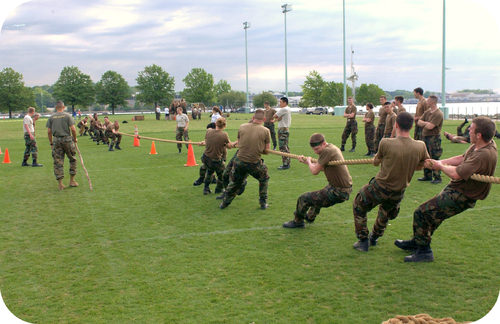化学平衡平衡
章节大纲
-
Pull hard!
::用力拉! 用力拉! 用力拉!A tug of war involves two teams at the ends of a rope. The goal is to pull the other team over a line in the middle. At first, there is a great deal of tension on the rope, but no apparent movement. A bystander might think that there is nothing happening. In reality, there is a great deal of tension on the rope as the two teams pull in opposite directions at the same time.
::拖拉队在绳子的尽头有两个小分队。 目标是把另一队拉到中间的一条线上。 首先,绳子上有很大的紧张,但没有明显的行动。 旁观者可能认为没有发生什么。 事实上,当两个小分队同时向相反方向拉时,绳子上有很大的紧张。Chemical Equilibrium
::化学平衡平衡Hydrogen and iodine react to form hydrogen iodide according to the following reaction:
::根据以下反应,氢和碘对碘化氢产生反应:
::H2(g) +I2(g) 2HI(g) 未来反应:H2(g) +I2(g) 2HI(g) 反反应:2H(g) +H2(g) +I2(g) +I2(g)Initially, only the forward reaction occurs because no HI is present. As soon as some HI has formed, it begins to decompose back into H 2 and I 2 . Gradually, the rate of the forward reaction decreases while the rate of the reverse reaction increases. Eventually the rate of combination of H 2 and I 2 to produce HI becomes equal to the rate of decomposition of HI into H 2 and I 2 . When the rates of the forward and reverse reactions have become equal to one another, the reaction has achieved a state of balance. Chemical equilibrium is the state of a system in which the rate of the forward reaction is equal to the rate of the reverse reaction.
::最初,只有前方反应才会发生,因为没有HI存在。一旦一些HI形成,它就会开始分解为H2和I2。逐渐地,前方反应率下降,反向反应率上升。最终,H2和I2生产HI的结合率等同于HI对H2和I2的分解率。当前方和反向反应率等同于对方时,该反应就达到了平衡状态。化学平衡是前方反应率与反向反应率相等的系统状态。Equilibrium in reaction: H 2 (g) + I 2 (g) → 2HI(g).
::反应平衡:H2(g) + I2(g) 2HI(g)。Chemical equilibrium can be attained whether the reaction begins with all reactants and no products, all products and no reactants, or some of both. Figure shows changes in of H 2 , I 2 , and HI for two different reactions. In the reaction depicted by the graph on the left (A), the reaction begins with only H 2 and I 2 present. There is no HI initially. As the reaction proceeds towards equilibrium, the concentrations of the H 2 and I 2 gradually decrease, while the concentration of the HI gradually increases. When the curve levels out and the concentrations all become constant, equilibrium has been reached. At equilibrium, concentrations of all substances are constant. In reaction B, the process begins with only HI and no H 2 or I 2 . In this case, the concentration of HI gradually decreases while the concentrations of H 2 and I 2 gradually increase until equilibrium is again reached. Notice that in both cases, the relative position of equilibrium is the same, as shown by the relative concentrations of . The concentration of HI at equilibrium is significantly higher than the concentrations of H 2 and I 2 . This is true whether the reaction began with all reactants or all products. The position of equilibrium is a property of the particular and does not depend upon how equilibrium was achieved.
::无论反应从所有反应物开始,没有产品,没有产品,没有产品,没有产品和没有反应物,或两者中的某些因素,都能够实现化学平衡。图显示H2、I2和HI的变化,两种不同反应的变化。在左边(A)的图表所描述的反应中,反应始于H2和I2。最初没有HI。随着反应向平衡的演进,H2和I2的浓度逐渐下降,而H1的浓度逐渐上升。当曲线水平向外移动,所有浓度都变得稳定时,已经达到平衡。在平衡时,所有物质的浓度都是不变的。在反应B中,过程只从HI开始,没有H2或I2开始。在这种情况下,H2的浓度逐渐下降,而H2和I2的浓度则逐渐增加,直到再次达到平衡。注意在这两种情况下,平衡的相对位置相同,正如相对浓度所显示的那样。平衡时的浓度明显高于H2和I2的浓度,这是事实,不论反应是所有反应从所有反应物开始还是所有产品开始,平衡的特性取决于如何实现。Equilibrium between reactants and products.
::反应器和产品之间的平衡。Conditions for Equilibrium
::平衡条件It may be tempting to think that once equilibrium has been reached, the reaction stops. Chemical equilibrium is a dynamic process. The forward and reverse reactions continue to occur even after equilibrium has been reached. However, because the rates of the reactions are the same, there is no change in the relative concentrations of reactants and products for a reaction that is at equilibrium. The conditions and properties of a system at equilibrium are summarized below.
::认为一旦达到平衡,反应就会停止,也许很诱人。化学平衡是一个动态过程。即使在达到平衡之后,仍然会发生前向和反向反应。然而,由于反应的速率相同,反应器和产品在平衡反应中的相对浓度没有变化,平衡反应系统的条件和特性概述如下。-
The system must be closed, meaning no substances can enter or leave the system.
::系统必须关闭,这意味着任何物质都不得进入或离开系统。 -
Equilibrium is a dynamic process. Even though we don’t necessarily see the reactions, both forward and reverse are taking place.
::平衡是一个动态的过程。 尽管我们不一定看到反应,但前向和反向都在发生。 -
The rates of the forward and reverse reactions must be equal.
::前进和反向反应的速度必须相等。 -
The amount of reactants and products do not have to be equal. However, after equilibrium is attained, the amounts of reactants and products will be constant.
::反应器和产品的数量不必相等,但是,在达到平衡之后,反应器和产品的数量将保持不变。
The description of equilibrium in this concept refers primarily to equilibrium between reactants and products in a . Other types of equilibrium include phase equilibrium and solution equilibrium . A phase equilibrium occurs when a substance is in equilibrium between two states. For example, a stoppered flask of water attains equilibrium when the rate of is equal to the rate of . A solution equilibrium occurs when a solid substance is in a saturated solution. At this point, the rate of dissolution is equal to the rate of recrystallization . Although these are all different types of transformations, most of the rules regarding equilibrium apply to any situation in which a process occurs reversibly.
::这一概念对平衡的描述主要是指反应物与产品在某一状态中的平衡。其他类型的平衡包括阶段平衡和溶解平衡。当物质处于两个州之间的平衡状态时,即出现阶段平衡。例如,中位水瓶在速度等于平衡时,即达到平衡。当固态物质处于饱和溶液中时,即出现溶液平衡。此时,溶解率等于再吸附率。尽管这都是不同类型的转化,但大部分关于平衡的规则适用于进程不可逆转地发生的任何情况。Summary
::摘要-
The concept of chemical equilibrium is described.
::介绍了化学品平衡的概念。 -
Conditions for chemical equilibrium are listed.
::列出了化学品平衡的条件。
Review
::回顾-
What is chemical equilibrium?
::什么是化学平衡? -
In the reaction illustrated in the text, does the equilibrium concentration of HI equal the equilibrium concentrations of H
2
and I
2
?
::在案文中说明的反应中,HI的平衡浓度是否等于H2和I2的平衡浓度? -
Does the position at equilibrium depend upon how the equilibrium was reached?
::平衡的位置是否取决于如何达到平衡?
-
The system must be closed, meaning no substances can enter or leave the system.


